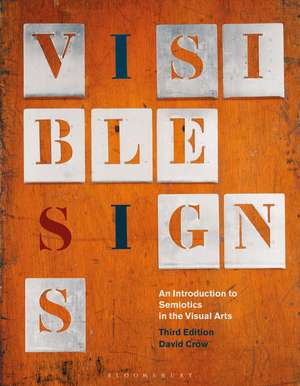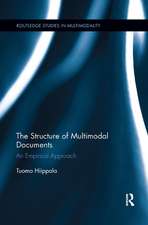Visible Signs: An Introduction to Semiotics in the Visual Arts: Required Reading Range
Autor David Crowen Limba Engleză Paperback – 31 aug 2018
Din seria Required Reading Range
- 18%
 Preț: 232.80 lei
Preț: 232.80 lei - 28%
 Preț: 203.39 lei
Preț: 203.39 lei - 17%
 Preț: 278.47 lei
Preț: 278.47 lei -
 Preț: 329.39 lei
Preț: 329.39 lei - 17%
 Preț: 260.20 lei
Preț: 260.20 lei - 13%
 Preț: 315.47 lei
Preț: 315.47 lei - 37%
 Preț: 229.08 lei
Preț: 229.08 lei - 8%
 Preț: 319.44 lei
Preț: 319.44 lei - 10%
 Preț: 226.26 lei
Preț: 226.26 lei - 12%
 Preț: 276.17 lei
Preț: 276.17 lei - 23%
 Preț: 235.80 lei
Preț: 235.80 lei - 20%
 Preț: 248.77 lei
Preț: 248.77 lei - 21%
 Preț: 207.54 lei
Preț: 207.54 lei - 21%
 Preț: 228.71 lei
Preț: 228.71 lei - 20%
 Preț: 281.25 lei
Preț: 281.25 lei -
 Preț: 192.59 lei
Preț: 192.59 lei - 18%
 Preț: 300.86 lei
Preț: 300.86 lei - 21%
 Preț: 192.91 lei
Preț: 192.91 lei - 37%
 Preț: 199.46 lei
Preț: 199.46 lei - 20%
 Preț: 281.87 lei
Preț: 281.87 lei -
 Preț: 239.14 lei
Preț: 239.14 lei - 12%
 Preț: 206.22 lei
Preț: 206.22 lei - 5%
 Preț: 258.90 lei
Preț: 258.90 lei - 11%
 Preț: 232.38 lei
Preț: 232.38 lei - 11%
 Preț: 275.11 lei
Preț: 275.11 lei - 12%
 Preț: 266.68 lei
Preț: 266.68 lei - 11%
 Preț: 282.17 lei
Preț: 282.17 lei - 12%
 Preț: 244.56 lei
Preț: 244.56 lei - 35%
 Preț: 201.01 lei
Preț: 201.01 lei -
 Preț: 277.47 lei
Preț: 277.47 lei -
 Preț: 206.98 lei
Preț: 206.98 lei - 20%
 Preț: 249.29 lei
Preț: 249.29 lei - 20%
 Preț: 282.62 lei
Preț: 282.62 lei - 19%
 Preț: 289.40 lei
Preț: 289.40 lei -
 Preț: 278.33 lei
Preț: 278.33 lei -
 Preț: 311.52 lei
Preț: 311.52 lei
Preț: 263.93 lei
Nou
Puncte Express: 396
Preț estimativ în valută:
50.50€ • 52.73$ • 41.80£
50.50€ • 52.73$ • 41.80£
Cartea nu se mai tipărește
Doresc să fiu notificat când acest titlu va fi disponibil:
Se trimite...
Preluare comenzi: 021 569.72.76
Specificații
ISBN-13: 9781350092655
ISBN-10: 1350092657
Pagini: 192
Ilustrații: 200 colour illus
Dimensiuni: 210 x 270 x 19 mm
Greutate: 0.68 kg
Ediția:3
Editura: Bloomsbury Publishing
Colecția Bloomsbury Visual Arts
Seria Required Reading Range
Locul publicării:London, United Kingdom
ISBN-10: 1350092657
Pagini: 192
Ilustrații: 200 colour illus
Dimensiuni: 210 x 270 x 19 mm
Greutate: 0.68 kg
Ediția:3
Editura: Bloomsbury Publishing
Colecția Bloomsbury Visual Arts
Seria Required Reading Range
Locul publicării:London, United Kingdom
Caracteristici
Provides a rich visual experience, so the book can be browsed as a visual sourcebook or explored fully as a grounding in basic theoretical ideas
Notă biografică
David Crow studied Communication Design at Manchester Metropolitan University. He subsequently worked as a designer in London for Assorted iMaGes and as Art Director for Island Records before running his own consultancy. As a freelance designer he worked for a range of clients in the cultural sector including Rolling Stones Records, Virgin Records, Phonogram and The Royal Shakespeare Company. Crow then moved into academia as Head of the Department of Graphic Arts at Liverpool John Moores University, UK. He is now Dean of the School of Art at Manchester Metropolitan University, UK.
Cuprins
IntroductionChapter 1: Components. What is Theory?; Agreement; Portfolio; Exercises.Chapter 2: How Meaning is Formed. Categories of Sign; Value; Portfolio; Exercises. Chapter 3: Reading the Sign: The Reader; Convention and Motivation; Portfolio; Exercises. Chapter 4: Text and Image: Digital and Analogue Codes; Advertising Writing; Portfolio; Exercises. Chapter 5: Official and Unofficial Language: Habitus; The Production of Legitimate Language; The Competition for Cultural Legitimacy; Unofficial Language; Portfolio; Exercises. Chapter 6: Symbolic Creativity: Hyperinstitutionalisation; Play and Identity; Portfolio; Exercises. Chapter 7: Junk and Culture: Dirt and Taboo; Rubbish Theory; Rubbish as a Resource; Portfolio; Exercises. Chapter 8: Open Work: Information and Meaning; Openness and the Visual Arts; Openness and Information; Form and Openness; Portfolio; Exercises. BibliographyIndexAcknowledgements and Picture Credits
Recenzii
This is an outstanding overview of semiotics which no student should be without. As expected of AVA titles, it is rich with examples of the theory and work being discussed and the points made are easily digestible ... It will prove invaluable to students of design ...
We already use the first edition and this revised and expanded second edition will make an excellent addition. Accessible use of language and an excellent visual approach and layout make this 'the' key text on semiotics for undergraduates studying graphic design and visual culture. The addition of self-directed study exercises is a useful teaching and learning aid. Excellent book.
Excellent content and user friendly approach to the subject of semiotics. More than just an introduction, the book deals with a complex subject in a highly visual and practical way. Highly relevant. Students will be encouraged to buy this book.
Very informative, well written and attractive.
A beautifully designed book inside and out (typography, layout and use of paper stock). The stickers add a level of interactivity that any student would like. This all adds up to a book that a student would want to keep for future reference. Content that is very relevant to an advanced graphic design course.
A very thoughtfully designed book. The material in this book can be accessed by Foundation Design students at both basic and more advanced levels, and gives advice that is in bite-sized intelligent morsels. The illustrations are contemporary and visually seductive. This is a useful and stylish book.
A great book, well designed, well researched, well written. For anyone in the slightest bit interested in this fascinating subject (and this should be all designers and design students) this book is the perfect guide.
I bought the original edition some years ago and have been recommending it to students ever since. Crow has written both editions in a way that is very appropriate to design students - good visual examples and very clear content.
Beautifully composed, well-structured, highly informative and relevant, providing essential theoretical content to our curriculum. A core text for undergraduate design courses and an excellent introduction to the fundamentals of semiotic theories.
I believe this would be an outstanding introduction for the graduate students joining the research group and for advanced undergraduates. Excellent, engaging layout. This really facilitates involvement with the text, and is much more interesting and accessible than many books I've seen on introductory semiotics.
Easy to follow, understand and written in a broad style that makes the publication relevant to all Art and Design pathways.
This publication has become an indispensable, and highly recommended entry point for students of visual communication who are engaging with semiotic terminology for the first time. It has been tried and tested as a productive catalyst for theory informing practice and practice provoking theory.
This book is an essential guide for those who are exploring the vast world of images and the meanings created by them. Each section of the book provides an overview of the theory of semiotics, and gives relevant visual examples to support the theory.
Visible Signs is a thorough, engaging and accessible overview to the fundamentals of semiotics. Through the use of relevant, contemporary examples Crow engages the reader visually, supporting the key theories.
This is the third edition of Crow's book (which was first published in 2003), and that speaks to its popularity. For this edition, Crow (dean of the School of Art, Manchester Metropolitan Univ., UK) added more up-to-date illustrations and rewrote the captions. Those who own the first or second edition will not need this updated edition, but those who do not should acquire it because it is one of the few books to discuss various semiotics theories of design. (A comprehensive study of the Peircean semiotic theory of graphic design will be published by MIT in 2017, but until then Crow's is one of the more complete.) Crow does a fairly good job of explaining the differences between Peircean and Saussurian semiotic perspectives, but the really outstanding parts of this book are the excellent illustrations and the exercises. This book is aimed at undergraduate programs in graphic design, and it hits the mark.Summing Up: Recommended. Lower- and upper-division undergraduates.
We already use the first edition and this revised and expanded second edition will make an excellent addition. Accessible use of language and an excellent visual approach and layout make this 'the' key text on semiotics for undergraduates studying graphic design and visual culture. The addition of self-directed study exercises is a useful teaching and learning aid. Excellent book.
Excellent content and user friendly approach to the subject of semiotics. More than just an introduction, the book deals with a complex subject in a highly visual and practical way. Highly relevant. Students will be encouraged to buy this book.
Very informative, well written and attractive.
A beautifully designed book inside and out (typography, layout and use of paper stock). The stickers add a level of interactivity that any student would like. This all adds up to a book that a student would want to keep for future reference. Content that is very relevant to an advanced graphic design course.
A very thoughtfully designed book. The material in this book can be accessed by Foundation Design students at both basic and more advanced levels, and gives advice that is in bite-sized intelligent morsels. The illustrations are contemporary and visually seductive. This is a useful and stylish book.
A great book, well designed, well researched, well written. For anyone in the slightest bit interested in this fascinating subject (and this should be all designers and design students) this book is the perfect guide.
I bought the original edition some years ago and have been recommending it to students ever since. Crow has written both editions in a way that is very appropriate to design students - good visual examples and very clear content.
Beautifully composed, well-structured, highly informative and relevant, providing essential theoretical content to our curriculum. A core text for undergraduate design courses and an excellent introduction to the fundamentals of semiotic theories.
I believe this would be an outstanding introduction for the graduate students joining the research group and for advanced undergraduates. Excellent, engaging layout. This really facilitates involvement with the text, and is much more interesting and accessible than many books I've seen on introductory semiotics.
Easy to follow, understand and written in a broad style that makes the publication relevant to all Art and Design pathways.
This publication has become an indispensable, and highly recommended entry point for students of visual communication who are engaging with semiotic terminology for the first time. It has been tried and tested as a productive catalyst for theory informing practice and practice provoking theory.
This book is an essential guide for those who are exploring the vast world of images and the meanings created by them. Each section of the book provides an overview of the theory of semiotics, and gives relevant visual examples to support the theory.
Visible Signs is a thorough, engaging and accessible overview to the fundamentals of semiotics. Through the use of relevant, contemporary examples Crow engages the reader visually, supporting the key theories.
This is the third edition of Crow's book (which was first published in 2003), and that speaks to its popularity. For this edition, Crow (dean of the School of Art, Manchester Metropolitan Univ., UK) added more up-to-date illustrations and rewrote the captions. Those who own the first or second edition will not need this updated edition, but those who do not should acquire it because it is one of the few books to discuss various semiotics theories of design. (A comprehensive study of the Peircean semiotic theory of graphic design will be published by MIT in 2017, but until then Crow's is one of the more complete.) Crow does a fairly good job of explaining the differences between Peircean and Saussurian semiotic perspectives, but the really outstanding parts of this book are the excellent illustrations and the exercises. This book is aimed at undergraduate programs in graphic design, and it hits the mark.Summing Up: Recommended. Lower- and upper-division undergraduates.











